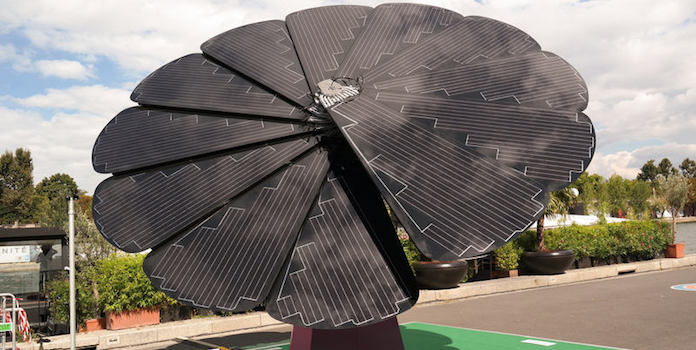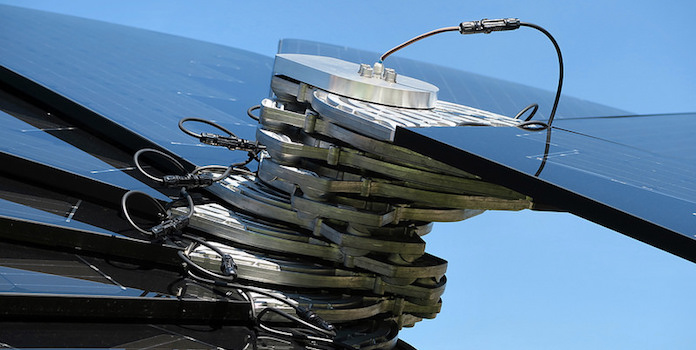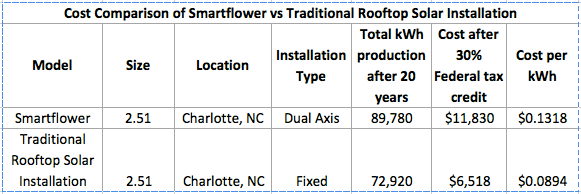Smartflower Cost vs Rooftop Solar Panels

While it is an attractive looking alternative to rooftop solar panels, how much does a Smartflower cost?
The Smartflower is billed as a self-contained residential solar installation produced by the Austrian manufacturing company of the same name. Each Smartflower has everything you need to start producing your own electricity: solar panels, inverter, wiring, and all the other bits and pieces. All you need to do is bolt it to the ground and plug it in. A major question, though, is what does the Smartflower cost vs rooftop solar panels? To answer that, let’s take a look at the Smartflower itself.
Latest Update About the Smartflower Cost and Availability (updated 8/27/2018)
Near the end of 2017 the original Austrian manufacturer of the Smartflower filed for bankruptcy but the U.S. division remains independent and will continue manufacturing in the United States. The SmartFlower cost is currently $16,900 for a single unit, but the Smartflower costs $22,000 for a complete system with batteries included. Read on for a price comparison of the Smartflower vs rooftop solar panels and be sure to visit our other post to dig even deeper into current solar panel cost.
For the last few years, Smartflower has begun pushing into the North American market, mainly targeting residential customers. This got us wondering about what makes the Smartflower so special, how much Smartflower solar cost, and if it’s a better financial investment than purchasing a more conventional roof-mounted solar installation.
What Is the Smartflower?
The Smartflower actually looks like a flower, with the solar panels as the “petals”. These petals are moveable and retract at night when the sun has set and then open up again when the sun rises. During high winds, the petals will retract to protect itself and they’re angled to self-clean as well.
There are currently three models available: the basic Smartflower Pop, the Smartflower Pop+ which includes batteries, and the Smartflower Pop-e which includes an electric vehicle charge port.
The actual solar installation is quite small, just 2.51 kilowatts. Compare this to the average US residential solar installation’s 5.6 kW and you can see what we mean – it’s less than half the size! However, the Smartflower has an ingenious trick up its sleeve that boosts electricity production way higher than an ordinary solar installation.
What Makes the Smartflower So Smart?

In short, the Smartflower is a dual-axis solar installation.
What exactly does that mean? Well, most residential solar installations are fixed permanently to a homeowner’s roof. The panels are flush with the roof, meaning all the panels are about 4 or 5 inches off the roof, but that 4 or 5 inches are consistent for every panel on the roof. This set-up makes the installation much cheaper and also much easier on the eyes since the solar panels blend in with the roof much better.
However, fixed panels present a problem. To work best, solar panels need to face the sun directly, at a right angle to the sunlight. Here’s the problem: the sun moves across the sky, but our solar panels are fixed to the roof.
Solar companies in North America always try to install panels on the south side of the roof – facing the sun – to maximize production, but that only solves a few of the issues. Even if the panels are facing due south, the sun still rises in the east and sets in the west, so the panels are directly facing the sun only for a short time in the noon hours. Also, the sun starts low on the horizon and rises throughout the day, then sets again at a different point on the horizon. So depending on your latitude and your roof’s angle, your panels are producing maximum energy only once a day.
The Smartflower is different. With a dual-axis tracker, the solar panels can follow the sun on two different axes: both side to side (from east to west) and up and down (as the sun rises higher in the sky and then sets), as well as all the infinite variations in between (it could chart a straight line, a curved line, an extremely curved line – basically whatever it takes to always face the sun exactly). Being able to follow the sun so precisely allows the owner to maximize energy production at all times.
Beyond increased energy production, the Smartflower manufacturer also touts that the panels operate at a lower temperature than typical residential installations, as wind can blow freely behind the panels, which increases the energy output of the installation (since panels are less efficient at high temperatures).
All of this adds up the Smartflower’s ability to produce much more electricity than a similarly sized conventional solar installation.
How Much Does a Smartflower Cost?
Right now you’re probably thinking “Wow, this thing is awesome! I need one immediately!” Hold your horses, though. Beyond the environmental benefits, solar is a financial investment. It’s a money saving venture and you need to know if the Smartflower makes sense for your bank account.
In the US, the Smartflower costs $16,900 (or $22,000 with batteries). How much you can save depends on your utility’s electricity cost as well as how strong the sunlight is in your area. To see if the Smartflower is a wise investment, we compared the costs and savings of going solar with this new product against a traditional roof-top solar installation of the same size:

For the above calculations, we use Smartflower’s own degradation rates (which account for soiling, temperature, inverter inefficiency, energy losses due to wiring, etc.) of 18% for their own product and 11% for rooftop systems. Since the Smartflower is self-cleaning and cooling, its lower efficiency is somewhat intriguing, though the manufacturer doesn’t offer any explanation as to why.
As you can see, we compare the Smartflower to a conventional rooftop solar installation of the same size in Charlotte, North Carolina. We totaled how much electricity (in kilowatt-hours) each solar installation would produce over 20 years – the typical lifespan of a solar installation. Note that the Smartflower will have produced almost 20% more electricity at the end of 20 years! Wow!
However, look at the total costs. We’ve already accounted for the 30% federal tax credit (which both systems are eligible for), and you can see the conventional solar installation is almost half the price of the Smartflower. Second wow!
For even more context, take a look at the cost per kilowatt-hour. In North Carolina, the average utility charges $0.1128 per kWh. From day 1, the rooftop solar installation is cheaper than the utility, but the Smartflower is about $0.02 more!
In areas that are much sunnier or see higher utility rates than North Carolina (southern California, Arizona, or Hawaii for example), the financials for the Smartflower would probably look much sunnier. Historically, utility rates increase about 2.5% annually, so in the end, even a North Carolina homeowner who purchases a Smartflower could potentially save money in the long run.
However, going solar with a Smartflower seems a little risky when there are more financially responsible options available.
Benefits and Drawbacks
As with any new technology or product, the Smartflower has both positive and negative sides:
Benefits
First off, the obvious: a dual-axis tracking system allows it to produce much more electricity than a standard roof-mounted solar installation. We’ve already gone through this.
Secondly, as it isn’t permanently attached to your property, you can take it with you when you move to a new house, avoiding all the hassle of transferring ownership of the solar installation to the new homeowner.
The manufacturer claims that the Smartflower only takes a few hours to install, compared to a few days for conventional roof-mounted systems. But with the long life of solar systems, does an extra day or two to install really matter?
Drawbacks
As we’ve seen, the biggest drawback is the high cost. For those living in areas with high utility rates and sunny skies, it might be financially viable. However, for most of us, a simple roof-mounted system offers much more bang for your buck, allowing you to save much more money by the end of the installation’s life.
Also, unlike roof-mounted systems, the Smartflower isn’t very scalable. If a homeowner uses a lot of electricity in their daily life, with a roof-mounted system you can simply add more solar panels until it’s enough. With a Smartflower, however, you’d have to buy multiple units (each with their own inverter and equipment, as each Smartflower is self-contained) to increase your installation size, thereby increasing your total cost more than is necessary.
The Smartflower also has a lot of moving parts. Yes, the solar panels have a 25-year warranty and the inverter has a 10-year warranty, but everything else has just a 2-year warranty. That doesn’t leave us with a lot of confidence in all those motors and wiring that open and close the “petals” every day and are constantly out in the elements.
Lastly, the looks will likely be somewhat polarizing. All the marketing materials show the Smartflower in the backyard of ultra-modern, angular houses shaded in whites and grays. It would probably look a bit out of place next to a run-of-the-mill shades-of-tan 1980s suburban US home. But beauty is always in the eye of the beholder.
The Bottom Line
The Smartflower is a fascinating new product on the residential market, but until the price drops to be a little more competitive with existing technology, it will likely continue to sit on the fringes of the industry.
However, just as with the ubiquitous rectangular solar panels we see everywhere, as adoption increases, prices drop. In fact, the company mentioned back in 2016 that as their presence in North America grows, they plan on sourcing parts from US companies (instead of importing everything from Austria). This hopefully will come with an accompanying price drop (though if, or how much, is anyone’s guess).
If you’re smitten with the Smartflower, but don’t want to spend that extra cash due to high Smartflower cost, be sure to watch for them in the future–you never know what will happen! If you want to see how much you could be saving with solar panels on your roof then enter your zip code below to compare.
Have you purchased or looked into the Smartflower cost? Tell us what you think in the comments below!
Image Credit under CC License via Flickr: https://flic.kr/p/HCUSyN & https://flic.kr/p/HUBW6Y
